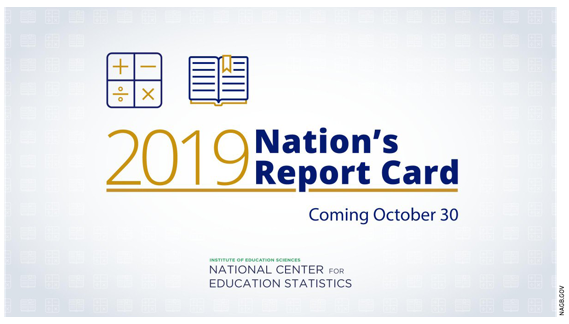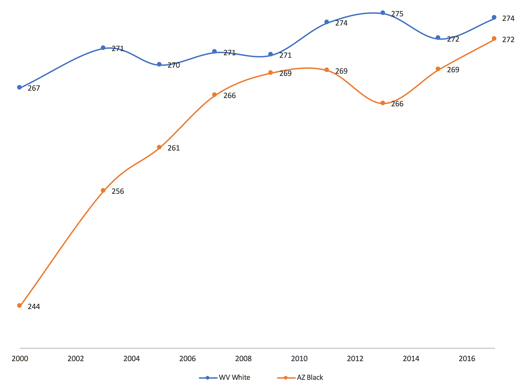 Editor’s note: Federal officials will release results from the 2019 National Assessment of Educational Progress, or NAEP, on Oct. 30. The congressionally mandated project administered by the National Center for Education Statistics, also known as “the nation’s report card,” provides group-level data on student achievement in reading and mathematics for grades 4 and 8. EducationNext asked four national education policy experts, including redefinED executive editor Matt Ladner, to predict this year’s findings. Ladner’s take is offered here.
Editor’s note: Federal officials will release results from the 2019 National Assessment of Educational Progress, or NAEP, on Oct. 30. The congressionally mandated project administered by the National Center for Education Statistics, also known as “the nation’s report card,” provides group-level data on student achievement in reading and mathematics for grades 4 and 8. EducationNext asked four national education policy experts, including redefinED executive editor Matt Ladner, to predict this year’s findings. Ladner’s take is offered here.
You can read predictions from Matthew M. Chingos, Sandy Kress, Susanna Loeb, Paul E. Peterson, Michael J. Petrilli and Morgan Polikoff in the full report, available here.
Greeks of antiquity consulted the oracle of Apollo for predictions about the future. The rituals involved the use of drugs and inhalation of mind-altering vapors among other things, like sacrificing a goat. Apparently in combination, these rituals inspired the oracle with the ability to make cryptic predictions with multiple possible interpretations – a handy skill when you don’t actually know much about the future.
The request to make predictions about the new NAEP data puts me in a dilemma similar to that of the oracle. NAEP results act like an oblong ball that bounces in unpredictable ways, and moreover, we have limited understanding of the policy factors influencing trends and even less understanding of the non-policy factors. Some of the things we think we know are probably mistaken, and we don’t agree on what we think is known.
Accordingly, I’ve decided to employ a modernized Delphic method. I’ll spare the goat, and I’m not much for inhaling vapors, but having consumed massive amounts of my drug of choice, caffeine, I will dare a few predictions.
Prediction 1: America continues to play in its academic food.
The 2009 to 2017 period proved broadly disappointing nationally. The country saw no progress in fourth-grade math or reading during this period, nor in eighth-grade math. The national average for eighth-grade reading improved by 3 points. In short, meh to sub-meh improvement.
Few states escaped the stagnation gravity well. Arizona and Mississippi students, though, did demonstrate statistically significant gains on all six NAEP exams given after 2009 (fourth-grade and eighth-grade math and reading 2009 to 2017, and fourth-grade and eighth-grade science 2009 to 2015).
Staring deeply into the prophetic clouds in my coffee, I’ll predict that the average state fails to reach a net +2 for the full 2009 to 2019 period. I hope to be wrong on this prediction.
Prediction 2: The 2018 strikes will leave a mark in the data.
Labor actions closed schools in 2018 in West Virginia, Oklahoma, Arizona, Los Angeles, Colorado and North Carolina. These strikes varied in length and breadth. Of course, we’ll never know what the 2019 NAEP scores would have been if these strikes had not occurred. Apollo’s caffeinated whispers, however, lead me to believe that kids learn more when they are in school than when they aren’t, and that many schools adhere to “make-up time” rules in a half-hearted fashion if at all. It won’t be possible to establish causality, and we would expect to find a mixed bag of results in these jurisdictions regardless, but a curious pattern of bubbles in my London Fog leads me to believe that a fairly consistent (negative) pattern may emerge. Again, I hope I am wrong on this one.
Prediction 3: Achievement gap milestone breached in the 2019 NAEP.
No state’s black student population has ever matched or exceeded the score for any state’s white population on any NAEP exam. The racial achievement gap has been deep enough that even the highest statewide average for black students has never matched that of the lowest performing statewide average for Anglo students. But it’s been getting close in recent years.

Arizona has had the highest performing African American student population, and their NAEP scores have improved strongly over time. The 2-point gaps seen in both 2009 and 2017 were very close. Scores for both West Virginia Anglos and Arizona black students may take a hit in 2019 (both states experienced strike-related school closures), but this may not prevent the lines from crossing.
Apollo sends word: 2019 will be the year where the highest performing black statewide group will bank a statewide average NAEP score higher than the lowest performing Anglo statewide average. Which is not at all to say that this is high enough, but it is an important milestone we have yet to cross. I hope I am right on this one!


